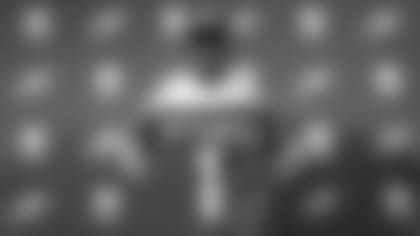
*
As we get closer and closer to the NFL Draft, a never-ending series of lists get posted by every football content provider under the sun ranking the top players at every position. Top 5 lists, mock drafts and big boards are all the rage this time of year. In this space, however, I want to look at these prospects a little differently.*
So as April 30 approaches, let's take a look at these players from the mindset of how NFL franchises and scouting departments look at them and that's by figuring out how they fit on a football team, rather than just list the "Top 5 linebackers" or the "Top 10 wide receivers."
Think about the offensive line. You wouldn't just want to know about the top linemen in the draft. You'd want a list of the top tackles, the top guards and the top centers. All three positions typically have different measurables and responsibilities, so they should be categorized that way, right? And then the standards at each position change from team to team, as every franchise has certain needs and specifications for what they look for as they build their roster. Some teams prefer size and strength, others place value on athleticism and others just want tough guys at certain positions. So let's dig deeper, and look at some of the top players may fit once they find homes in the NFL ...
It's safe to say that anyone who has read any of my work knows that I have a passion for football. Of all the aspects of the game that I love the most, front seven play ranks near the top. Conventional wisdom among fans throughout the years has split "defensive line" into two groups: defensive end and defensive tackle. In recent years, terms such as "5-technique" have become common nomenclature for defensive ends in a 3-4. But is it that simple? Are all defensive tackles the same? And what about defensive ends? For help with this, I reached out to a coach whom I've worked with in the past and from whom I've learned a lot about defensive front seven play by watching him teach players at the collegiate level.
Jared Backus is currently the defensive coordinator and outside linebackers coach at Cornell. I had the pleasure of working with Coach Backus for three seasons at Temple University where he spent time as the defensive line and linebackers coach. He's coached several NFL players (including former first-round pick Muhammad Wilkerson and third-round pick Terrance Knighton), and is a great teacher of the game of football. We had a great discussion about different roles that prospects can play along a defensive line, and the different traits teams look for in each of those specific roles.
In today's game, teams deploy so many different looks and formations up front, so I don't view traditional "4-3 defensive ends" as pure defensive linemen. You'll see players stand up in a two-point stance, move around the formation and attack the quarterback from different angles. These types of players, whether you regard them as "4-3 defensive ends" or "3-4 outside linebackers," are what I call "edge Players," and they are a group I will address in their own piece later this week. In this piece, I want to address the players who historically have just been referred to as "defensive tackles," the big men up front who almost always play in a three-point stance with their hand on the ground doing the dirty work up front.
Not all of these players are the same though, and they shouldn't all be looked at under one giant umbrella. Someting else to take into consideration is the difference between 1-gap and 2-gap schemes, which I'll bring up numerous times in this piece. Teams will mix and match, with 2-gap teams having some plays that call for 1-gap principles and vice versa, but there is a difference between the two. With a 1-gap scheme, linemen line up in one gap between two offensive linemen, and they are responsible for that gap. With a 2-gap scheme, you'll see linemen play head up over a blocker and are responsible for both blocks on either side of them.
As I've previously done in this Eagle Eye pre-draft series, I'll break up this position into subgroups. Keep in mind, these groups aren't necessarily positions where a player will line up at for 80 snaps a game. They are roles that are played that can be fit into a number of different defensive play calls. Take Fletcher Cox, for example. Many would call Cox a "5-technique" defensive end, as if that is his only position. But Cox, much like teammate Cedric Thornton, lines up at 5-technique, 4-technique, 3-technique and even 0- or 1-technique at times. I will use college prospects as examples for each of these positional roles, but it should be noted that most of them have the versatility to fill multiple jobs on a defense. First up, let's start inside with nose tackles.
Nose Tackles
Nose tackles have almost always been associated with 3-4 (or "odd") fronts, as the big, beefy run stuffer inside who can take on multiple blockers and keep their linebackers clean. While that is true, nose tackles also play a role in many 4-3 (or "even") fronts. The nose tackles who would historically play in an odd front are often referred to as a "0-technique", while the nose tackles in an even front are called a "1-technique," or a "shade player." Let's begin the discussion with the big men, the 0-techniques. A nose tackle is lined up as a 0-technique if he is directly headup over the center. You'll see this in a lot of base packages from most odd-front, 2-gap teams. What do coaches look for from a 0-technique?
"Number one, this guy is built big, wide and strong," Backus explained, "because in the run game he has to two-gap the center and play both A gaps."
What does that mean? Imagine a nose tackle playing eye-to-eye against a center, right over top of him in his stance. At the snap of the ball, he fires out of his stance, stays low, leads with his hands and gets inside the center's pads, shocking him on contact and locking out his arms and getting full extension (Cox isn't playing the nose here, but you can see him lock out his arms). Once he's got full control of the blocker, he's got to get his eyes on the ball carrier and read which gap he's running into. If he reads inside, he falls in and if he reads outside, he falls out. But it all starts with the ability to stay low, get inside the blocker before he can get inside of you and control him on contact. The result is a player who is responsible for two gaps up front, making it easier for your linebackers to key and flow to the football.
It's not just the center that a 0-technique has to contend with, however.
"The reason why you want these guys to be heavier and big and strong is so that when the guards knock down on him, he won't get backed out of there," Backus said. "He's not going to be a pretty lineman. He's sort of ugly but he gets the job done because he's strong and powerful."
These players have to be able to take on a double team, hold their ground and keep the linebackers behind them clean so they can make plays.
"In the passing game, this guy has to push the pocket backwards and affect the launch point of the quarterback," Backus said. "There's not a lot of edge rushing. He's attacking and because of how strong he is he should be able to push the center straight back into the pocket."
Who in this class fits that description best? You have to start with Washington's Danny Shelton. At 6-2, 339 pounds (which is as light as he's been in a while, reportedly), Shelton is a large man with a huge lower body. He's very stout at the point of the attack and holds up against the run very well. Perhaps the most intriguing part of Shelton's game, however, is his natural athleticism, which is scary for a guy his size.
Look at Shelton move on this play and help clean up a pile along the sideline downfield. Guys that size don't usually move that way, and that's what has earned Shelton comparisons to former first-round pick Dontari Poe (who plays on the nose in Kansas City's odd front) or Vince Wilfork. Shelton's not too tall, which is a good thing inside, where he can use his natural leverage to gain an advantage early in the down.
One prospect where height may affect his ability to play inside is Jordan Phillips from Oklahoma. Phillips stands at 6-5, 329 pounds, and at that height he may have some issues creating leverage at times. Some experts project him as a potential defensive end in an odd front. When you watch him play, however, he's got the look of a big-time prospect. He played at the 0-technique for the Sooners, and like Shelton he possesses somewhat freakish athleticism for a man that size.
On this shot (courtesy of NFL.com), Phillips uses an armover move to immediately get into the backfield and secure a tackle for loss. Phillips flashes the ability to be immovable at the line of scrimmage, taking on double teams and showing a good feel for 2-gapping offensive linemen. He's viewed by many as one of the most high-upside linemen in this draft.
One prospect who is flying under the radar a bit is Joey Mbu. The former Houston Cougar has the longest arms (35 inches!) of any defensive lineman in this draft who was invited to the Combine, and he repeatedly used that length on the field. A comfortable 2-gapper with violent hands and a strong anchor at the point of attack, Mbu isn't the most athletic defender in the class but his ability to defend the run is very valuable.
Mbu is lined up as a 1-technique here, but you see his ability to use his length to control the blocker, use his live feet to stay alive and follow the action down the line of scrimmage and ultimately make the stop.
Another player who defines the term "space eater" is UCLA nose tackle Ellis McCarthy. At just under 6-5, 338 pounds, the former Bruin is a behemoth inside who showed the ability to really hold up against the run. If he can put it all together from a technique standpoint, he could be one of the sleepers in the draft class along the defensive line.
Next up you have 1-technique tackles, who instead of lining up head up over the center, line up in the gap between the center and the guard. With 1-techniques (or "shades"), you're looking for some similar traits. He has to take on double teams from guard-center combo blocks. He's got to be able to be stout at the point of attack. Backus explained though that there are some slight differences between the two.
"A lot of times you want your 'shady' to be a little more active. It's not like the 0-tech. He's in a gap, so you might ask him to make more athletic plays in the run game as far as being upfield and not getting stuck on the line of scrimmage or reading as much as the 0-tech," Backus said.
That makes a lot of sense, when you think about it. As a 1-technique, he's playing over an A gap, or right between the center and guard. In a one-gap scheme, you're going to ask him to shoot that gap and get into the backfield, so a level of quickness and burst is necessary. He'll still have to handle some double teams, however, so the ability to hold up at the point of attack and not crumble against a combo block is important as well.
Who fits that bill in this class? Shelton and Phillips certainly have the athleticism and burst to handle that type of role in an even front, but Carl Davis from Iowa is another guy with the skill set to handle this type of role. At just under 6-5, 320 pounds, Davis boasts huge hands (11 inches, the biggest of any d-lineman at the Combine), long arms and a strong, athletic frame. He can anchor down against a double team, control the line of scrimmage and use his length very well in the run game. He only had 3.5 sacks in college, and his level of effort and conditioning have been questioned by some, but when you see a guy move like this ...
... you can't help but fall for the potential. Davis has great athleticism, great strength at the point of attack and he had a great week of practice at the Senior Bowl. If he can put it all together, he has the ability to fit as a 1-technique or even possibly as a defensive end for an odd-front team.
Florida State's Eddie Goldman is another prospect who fits inside as a 1-technique. A junior who continued to add weight after the season, Goldman tipped the scales at 336 pounds at the Combine and carried it well. Goldman still has work to do from a technique standpoint, but has plus short-area burst and the ability to anchor down at the point of attack. He should be a good fit inside for a team looking for a nose tackle, whether it's at the 1- or the 0-technique role.
Two prospects at the East-West Shrine Game stood out as possible options inside. Maryland's Darius Kilgo and Stanford's David Parry both enjoyed good weeks of practice and played on the nose in odd fronts for their respective teams. Kilgo showed great initial quickness off the ball as a 1-technique in Maryland's 3-4 scheme. The 6-1, 308-pound Parry is a bulldog of a player with a fire-hydrant frame that was near unblockable during practices. Both are potential late-round picks who can fill as role players at the next level.
3-Technique Tackles
The term "3-technique" is often what is used to describe any defensive tackle in a 4-3 defense. One-technique tackles are also found in a 4-3, but when you think of the most disruptive players at the position over time, a lot of them have been 3-techniques. Think of Warren Sapp in his prime with Tampa Bay. A 3-technique lines up on the outside shoulder of an offensive guard. These players are theoretically quick, explosive and disruptive. Why are those players put in such a good position to make plays?
"At that spot between the guard and the tackle, he's right in the line of fire. There's a lot of action there. A lot of teams will move their 3-technique around to where the action is. If it's pass, he's got a one-on-one matchup with the guard so if he's a guy that wins with quickness and he can beat a guy up the field that should be a mismatch," Backus said. "You can move him around schematically and match him up on a certain player that's weaker in pass pro and that's an advantage for the defense. If he's a really active player then you can get a lot of production out of him."
Who are the disruptors in this draft class who could play inside as a 3-technique?
Malcom Brown from Texas has received a lot of first-round consideration in mock drafts since he declared back in January. A quick, relentless player with good athleticism and the versatility to line up in a number of different spots, Brown is seen as a fit for a number of schemes at the next level. A reportedly high-character prospect with few holes in his game, Brown is viewed by some as a potential Top-20 pick, while others see a potential second-round selection, but regardless his ability to get after the quarterback is not under question.
One player who is a favorite of many of the analysts that watch the tape on these prospects is Clemson's Grady Jarrett. A shade under 6-1 and 304 pounds, Jarrett beat offensive guards with quickness, leverage and an assortment of pass rush moves. NFL Films senior producer Greg Cosell noted that he has some traits similar to 2014 first-round pick Aaron Donald.
You can see Jarrett's ability to win against guards in this one-on-one drill at the Senior Bowl, where he wins with a quick hand swipe and beats Alabama's Arie Kouandjio. Jarrett isn't the biggest or strongest player at his position, but he has traits that translate into a quality NFL 3-technique.
One player who I personally have a bit of a mancrush on is Rice defensive tackle Christian Covington. At 6-2, 289 pounds, the Canadian lineman has a really good first step, shoots gaps quickly and has the ability to 2-gap as well at the point of attack. A tough, productive player at Rice, he dislocated his kneecap (ouch) in November, and missed the pre-draft process, but Covington looks like a moldable talent who could develop into a Mike Daniels-type talent down the road.
At 6-3, 300 pounds, Auburn's Gabe Wright has prototypical 3-technique size, and with his quick, active hands, variety of pass rush moves and ability to close on the ball, he's got a skill set that you can believe in for future production.
In this shot from the Senior Bowl, you can see Wright's ability to shoot off the ball, get into the backfield relatively untouched and bring a tough running back in David Cobb to the ground on this stretch run play.
Ohio State's Michael Bennett missed the Senior Bowl due to injury, but he's got a very similar build to Wright and owns a similar skill set. Bennett lined up at a 1-technique as a junior in 2013, but slid out to the 3-tech as a senior and looked much more effective. A heady player with good first-step quickness, Bennett should transition well to the NFL.
Florida State defensive lineman Mario Edwards, Jr. has gained a lot of hype as of late, with some saying he could sneak into the first round. After a sophomore season that ended with a BCS title for the Seminoles, Edwards was tabbed as a future blue-chip prospect, but following what has been reported as an up-and-down junior campaign, his prospects look a little more bleak. At just under 6-3, 279 pounds, Edwards is a bit light for a 3-technique, but isn't quite explosive enough to win off the snap as an edge rusher either. His best bet may be to add more weight and stay inside as a 3-tech in the NFL.
Like Clemson's Jarrett, another player who gets a lot of love from analysts is Indiana's Bobby Richardson. What's interesting about Richardson is that, at 6-2, 283 pounds, he played as a defensive end in a 3-4, 2-gapped consistently, but showed really good 1-gap traits in that he can get upfield quickly, has a great short-area burst and has as high a motor as any player at his position. Richardson absolutely has the movement skills to play 3-technique in the NFL.
Washington State's Xavier Cooper and Arkansas' Darius Philon are two underclassmen who are built in similar fashion to Richardson. Cooper tested very well at the Combine, and with 31.5 career tackles for loss and 13 sacks, had a very productive career for Wazzou. A disruptive player with great quickness, agility and overall athleticism, Cooper is a great fit in a 1-gap scheme as a 3-technique tackle. Philon is a bit shorter at 6-1, 298 pounds, and is one of those players who absolutely fits better in a 1-gap scheme as opposed to a 2-gap system. Philon has to get stronger at the point of attack, but he's got a good armover pass rush move and shows the motor to stick as a reserve at the next level.
Odd-Front Defensive Ends
I mentioned earlier that the common term for defensive ends in a 3-4 is "5-technique." That isn't necessarily wrong, but it's not exactly 100 percent right, either. Sure, you'll see those players line up as a 5-tech on a good amount of snaps, but for most 2-gap odd-front teams, on base downs you'll see those defensive ends head up on the tackle, as opposed to on the outside shoulder. This slight change makes it a different role entirely. When a player is head up over a tackle, they are referred to as a 4-technique.
Backus said that a 4-technique "has to be bigger and more rugged, because playing head up on offensive tackles, who are the biggest guys on the line, you've got to be able to hold your ground."
Between that and then holding up against the combination blocks between the tackles and guards, a 4-technique is faced with a tough challenge and it requires a certain type of player.
"If you're too small," Backus said, "you're going to get bounced around inside, but you need to be athletic enough to potentially be a contain player in the run defense and rush the B gap as well, so there's a lot of responsibility there."
With a 5-technique, you're lined up on the outside shoulder of the tackle, so you're less likely to take on a guard/tackle double team. Now, there will be times when you have to take on a tackle/tight end combo block, but it's still a bit of an easier task. That's why Backus said, "you can get away with a little less size at the 5 ... his gap is defined so he may be able to run up the field and play more outside the tackle. If you've got a bigger guy that's a good pass rusher, he can be effective there."
From an Eagles perspective, think of their defensive end rotation. In base formations, you'll often see both Cox and Thornton lined up as 4-techniques because of their ability to hold up against the run. Both also have the athleticism to rush the passer from the 5-technique spot as well. But it's rare to see Vinny Curry rush from the 4-technique, and that's good coaching. Curry will get rush opportunities from the 5-tech but also sees a lot of reps at 3-technique in nickel fronts. But as a 4-technique, holding up against guard/tackle combination blocks may not be what you want Curry doing on a down-to-down basis, so the coaches don't typically utilize him in that role.
Billed by many as the top defensive player in the entire class, USC defensive tackle Leonard Williams has ideal size (6-5) and length (34-1/2 inch arms) to play as an odd-front end, either as a 4- or 5-technique. A very strong run defender who knows how to use his length to gain separation from blocks and flow to the football, Williams is a heady player and very fluid mover. He's got a high motor, and while his pass rush numbers weren't through the roof, (13 sacks in 35 starts), he's got enough ability there to have success as a 5-technique rusher. He may be a bit tall for a 3-technique, but Williams will make a team in the top-10 pretty happy down the road.
Williams may be a better player than Oregon's Arik Armstead as we stand here today, but it wouldn't shock me at all to see the latter become the better player five years from now. Blessed with a remarkable combination of size and athleticism, Armstead (a former basketball player at Oregon), lined up mostly at 4-technique for the Ducks and displayed the ability to hold up against double teams at the point of attack as well as chase down screens in space and make plays in pursuit.
In this shot against Michigan State (courtesy of NFL.com), Armstead takes on a down block from the right tackle, sheds him and makes a tackle for loss. Armstead's physical tools are top-notch, and in the right situation, he could be a perennial Pro Bowl talent.
Armstead's Pac-12 cohort Henry Anderson from Stanford best profiles as a defensive end in an odd front as well. At 6-6, 294 pounds, Anderson lined everywhere from 0-technique to 7-technique in the Cardinal's multiple front system. He's got good length, good athleticism (he was one of the top testers in the defensive line group at the Combine) and if he can continue to improve as a technician he has the ability to be a very reliable starter in a 3-4 scheme.
One of the more intriguing defensive linemen in this draft is Arizona State's Marcus Hardison. At 6-3, 307 pounds, Hardison has a huge wingspan and, despite being that size, lined up as a defensive end in a 4-3 scheme.
Some see Hardison as a 3-technique (which is where he is lined up on this shot from the Senior Bowl), others see a 5-technique, but his ability to win as a high-side rusher on the outside shoulder of the tackle could make him an attractive option in the mid-to-late rounds.
At the Shrine Game, Louisville's B.J. Dubose showed off the same positional versatility he displayed during his time in college. At 6-4, 284 pounds, Dubose lined up as a 4-technique in odd fronts, as well as a 7-, 5- and 3-technique. Many see his best fit as an odd-front end, but he could play as a strongside defensive end in a 4-3 scheme as well.
As I touched on in the beginning of this piece, a lot of these players have the flexibility to play in multiple spots (think of Carl Davis or a Jordan Phillips), while others may only have the ability to win just from one spot along the line. What types of players are most effective? Would you rather have the "jack of all, master of none" to help you out in a multitude of areas and play a number of roles, or would you rather have the guy with less versatility but a distinct role in your defensive scheme. To Backus, it just depends on your team.
"I think that might be constantly changing just based off the needs of your team," Backus said. "I know sometimes at the college level that we don't always have the flexibility to (just play a guy in one role to let him thrive). It helps having a guy that can play all over for you, but if you have a guy that can get you 10 or 15 sacks by playing just one role, those guys win football games for you."
In the defensive front seven, you can definitely envision scenarios where role players can be very effective. Whether it's subpackage 3-technique rushers or run stuffing 1-techniques who play in short-yardage situations, the ability to plug guys in and play them to their strengths can be very effective. There is something to be said, however, for that positionally versatile player who can wear a number of hats for you as well. Depending on what your team needs, they may choose to go one way or the other, but now you have an idea of the different roles where guys can have success and best fit in the NFL.
Fran Duffy is the producer of "Eagles Game Plan" which can be seen on Saturdays during the season. Be sure to also check out the "Eagle Eye In The Sky" podcast on the Philadelphia Eagles podcast channel on iTunes. Prior to joining the Eagles in 2011, Duffy was the head video coordinator for the Temple University Football team under former head coach Al Golden. In that role, he spent thousands of hours shooting, logging and assisting with the breakdown of the All-22 film from the team's games, practices and opponents. !















